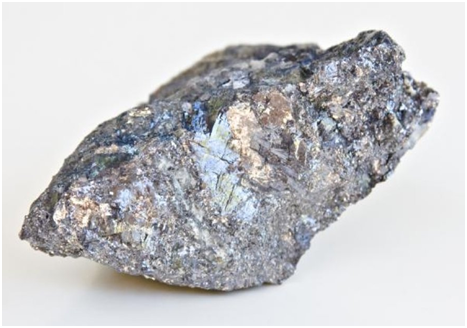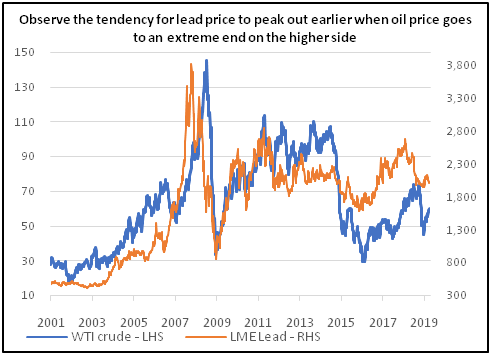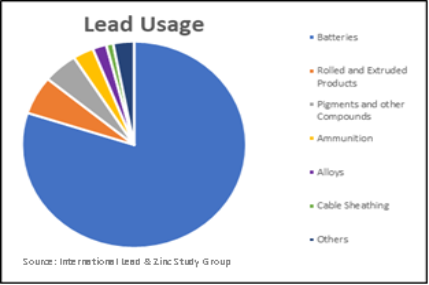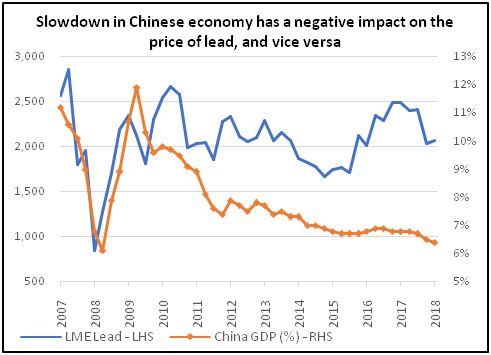
 We will now turn our focus towards lead, a metal that is widely used today because it isductile, malleable, has a low melting point, and can resist corrosion. Compared to other non-ferrous metals however, lead is heavy, weighing around 11.3 grams/cm3. Lead is mainly extracted from Galena, an ore that contains lead (around 86%), sulphur (around 13%), and traces of silver (around 1%). Recycling lead is easy, cost effective, lowers the release of lead into the environment, and retains the quality and impurity of lead obtained from mining. Because of these factors, nearly half of lead’s global production comes from recycling the metal.
We will now turn our focus towards lead, a metal that is widely used today because it isductile, malleable, has a low melting point, and can resist corrosion. Compared to other non-ferrous metals however, lead is heavy, weighing around 11.3 grams/cm3. Lead is mainly extracted from Galena, an ore that contains lead (around 86%), sulphur (around 13%), and traces of silver (around 1%). Recycling lead is easy, cost effective, lowers the release of lead into the environment, and retains the quality and impurity of lead obtained from mining. Because of these factors, nearly half of lead’s global production comes from recycling the metal.
Lead derivatives are traded around the world. LME and SHFE are two of the major exchanges that offer trading in lead. In India, lead futures is traded on the MCX platform.
Lead usage
As stated earlier, lead is ductile, malleable, has a low melting point, and can resist corrosion. These features make lead quite valuable across a range of industrial applications. A vast majority of lead that is produced goes into motor vehicles in lead-acid batteries. This segment occupies 80% of the demand for lead. Despite being discovered well over a century ago, lead-acid batteries are still the most preferred batteries that are used in today’s vehicles. In fact, over a billion vehicles around the world are powered by lead-acid batteries.Lead-acid batteries are preferred over other batteries because they offer high efficiency, high reliability, high performance, are quite affordable, are safe, and are easily recyclable.
The rest of the demand for lead – a fifth of the total – comes from other applications.Some of these applications are stated below:
-
As lead is well known to absorb electromagnetic radiation,it is used in x-ray equipments to shield patients against harmful electromagnetic radiation as well as in nuclear reactors.
-
Because it is inexpensive, has a low melting point, and is heavy, lead is used to make bullets and ammunition.
-
Lead is also used to make alloys, such as bronze, solder etc. For this, lead is combined with other metals such as copper, aluminium, and tin.
-
As lead is known to absorb sound and vibration because of its high surface density and weight, it is used in making industrial sheets that are fitted around walls to minimize sound from traveling across them.
-
As lead is known to resist water and prevent leaks, it is also used for waterproofing purposes such as in roofing, weathering etc.
Factors that impact the price of lead
Some of the major factors that impact the price of lead have already been discussed in the previous chapters. These include the dollar, with which lead shares a negative correlation; and market risk appetite, with which lead shares a positive correlation. Besides, lead is impacted by its warehouse inventory levels in the same way other non-ferrous metals are impacted by their respective warehouse inventory levels. The other major lead-specific factors that impact the price of lead are as mentioned below:
Health of the global auto sector
Given that lead is primarily used in lead-acid batteries that are installed in vehicles, the health of the auto sector plays acrucial role in influencing the price trajectory of lead. A robust global economy boosts consumer sentiment, which in turn increases demand for consumer discretionary products such as automobiles. And as manufacturers anticipate a pickup in the demand for automobiles, they increasethe production of vehicles.This in turn boosts demand for lead-acid batteries. On the other hand, a weakening economy has the opposite impact on the demand for lead-acid batteries and subsequently on their prices.
 One important variable that can influence the demand for automobiles is interest rates across important economies such as China, US, Euro area, UK, Japan, and India. Automobiles are usually financed using mortgages. Generally speaking, the higher the interest rates move, the greater is the likelihood that demand for automobiles and subsequently for lead-acid batteries will weaken, and vice versa. Another factor that can sometimes influence the demand for automobiles is the price of crude oil. As crude oil has a direct impact on the pricing of gasoline and diesel, its trajectory can impact auto sales, especially during periods of sharp price swings. Ahuge spike in the price of crude oil, for instance, might negatively impact auto sales, and vice versa.This in turn could reduce demand for lead-acid batteries and thereby cause lead prices to decline.
One important variable that can influence the demand for automobiles is interest rates across important economies such as China, US, Euro area, UK, Japan, and India. Automobiles are usually financed using mortgages. Generally speaking, the higher the interest rates move, the greater is the likelihood that demand for automobiles and subsequently for lead-acid batteries will weaken, and vice versa. Another factor that can sometimes influence the demand for automobiles is the price of crude oil. As crude oil has a direct impact on the pricing of gasoline and diesel, its trajectory can impact auto sales, especially during periods of sharp price swings. Ahuge spike in the price of crude oil, for instance, might negatively impact auto sales, and vice versa.This in turn could reduce demand for lead-acid batteries and thereby cause lead prices to decline.
Chinese demand
China is the world’s largest consumer of lead, accounting for around two-fifths of the world demandeach year. Given such a huge share, the nation plays a crucial role in influencing the broader price trends of lead. While auto sector is arguably the most important factor impacting demand for lead from China, another sector that influences demand for the metal is power. Lead batteriesare used not only in vehicles but also in industries to provide a stable and secure power for various applications that require a continuous flow of electricity. As such, economic health of China plays a crucial role in deciding the price trend of lead. A stronger Chinese economy would boost demand not only for vehicles but also for various industrial activities, all of which will increase demand for lead batteries and subsequently underpin lead prices. A weakening Chinese economy, on the other hand, would have the opposite impact.
Chinese supply
China is not only the world’s largest consumer of lead, but is also the world’s largest producer of lead, contributing to around two-fifths of the world’s supplies each year.As such, lead prices are also influenced by the supply trends from China.Reduction in Chinese supplies tends to tighten the global markets, especially if this reduction is accompanied with low inventory levels and strong demand. The opposite is also true in case there is an increase in Chinese supplies.
One of the key factors that has been impacting Chinese supplies over the past few months is steps taken by Chinese authorities to reduce environmental pollution. In order to do this, the Chinese government has been introducing stringent environmental norms. These norms also include cracking down on polluting mines and smelters, an action which can impact the operating levels of some of the lead mines and smelters too.If this hampers the primary and secondary output of lead from China, it would tighten the global supplies, especially if demand for the metal remains strong.
Another factor that would indicate the current situation of lead market in China is the fees that Chinese smelters get to process lead concentrates into refined metal, called TCs (Treatment charges) and RCs (Refining charges). TCs/RCs also reflect the profits that smelters earn from processing lead concentrates. Generally, a low TC suggests at a tight concentrate market, and vice versa. A low TC/RC if also accompanied by low lead price would significantly reduce the profit potential for smelters, who could then possibly reduce their output level, which in turn could tighten the market for refined lead. On the other hand, a high TC/RC if also accompanied by high lead price would increase the profit potential for smelters, who could then possibly boost their output level, which in turn could cause an oversupplyof refined lead.
Potential health hazards and availability of substitutes
Lead is an extremely harmful metal that is known to be very toxic to human health. Studies have found out that exposure to lead can damage the nervous system and cause neurological disorders. Lead is said to be even more harmful to children, as their body tends to absorb lead more than an adult body does. Besides impacting the human brain, exposure to lead can damage kidney, liver, and increase the risk of high blood pressure among people.
Because of the severe health hazards of exposure to lead, the usage of the metal has been phased out from a lot of applications where humans could come in direct contact with it. Some of these include the usage of lead in paints, water pipes, and fuel. Each of these significantly increased the risk of lead being inhaled or consumed by humans, and hence were banned by governments around the world. Today, lead is only used in areas where its exposure to humans is extremely low to virtually nil. Examples include lead-acid batteries.
Lead extraction and production damages not only the air, but also soils and waters. Given that environmental norms are becoming tighter with each passing day and given the harmful impact lead exposure has to a human body, there is a possibility that the metal could be gradually phased out from more applications once the economic alternatives and substitutes to lead become available. One area where this is happening is in the automotive segment. Generally, gasoline and diesel-based engines have lead-acid batteries, while electric vehicles (EVs) have lithium-ion batteries. As the environment goes green, EVs could eventually displace traditional vehicles in the future, which in turn could reduce the need for lead-acid batteries, and thereby lower a major source of demand for lead.
As such, the major long-term risks that the lead industry faces are the potential health hazards of exposure to lead on the human health and the availability of economic and viable substitutes.
How to trade lead
When trading lead, some of the key things to keep a track of are as mentioned below:
-
Monitor LME data regularly in order to identify trends in inventories and to know if they are at an extreme or are reversing.
-
Keep a track of the health of the global auto sector, considering that 80% of lead’s demand comes from lead-acid batteries which are used in vehicles.
-
Monitor economic data from China to gauge the health of its automotive and power sector.
-
Keep a track of the pace of developments in the EV segment. A sooner-than-anticipated increase in their usage at the cost of traditional vehicles could reduce demand for lead-acid batteries and subsequently for lead.
-
Monitor the monetary and fiscal policy, primarily of China, to understand whether economic conditions are accommodative or tightening.
-
Keep a track on movements in global equities and other commodities to understand the prevailing sentiment in the market.
-
Keep a watch on the medium-term and long-term trend of the dollar, given the negative correlation between the two.
-
Compare LME inventories with LME price spreads, as this gives clues as to the prevailing tightness of lead in the physical markets.
Next Chapter
Comments & Discussions in
FYERS Community


Ramdas K C commented on July 10th, 2019 at 10:37 PM
How the Dollar affects negatively to the lead price action.
tejas commented on August 14th, 2019 at 5:14 PM
Just like all commodities which are priced in USD, the USD has an inverse correlation with commodity prices. In effect, if USD goes up, commodities go down and vice versa. It's the same for lead. But you must remember that since you're trading on MCX, the consequences are different. If the rupee weakens against USD, then the price of commodities will proportionately increase. Why? Because you'd have to pay more rupees to buy the same quantity of the commodity.